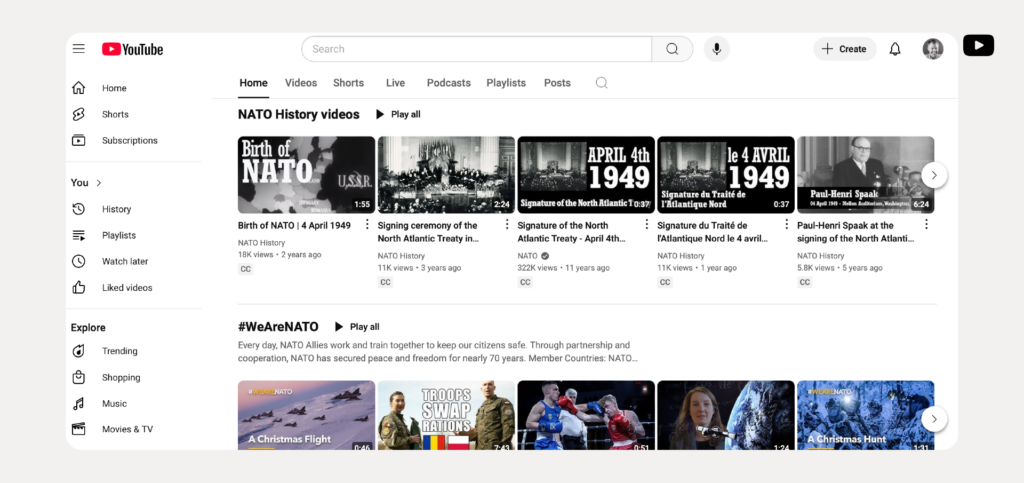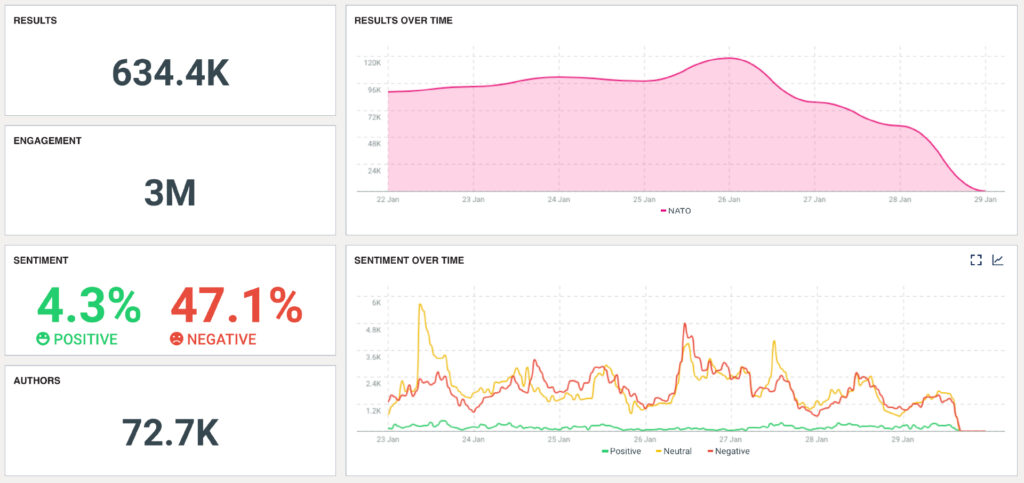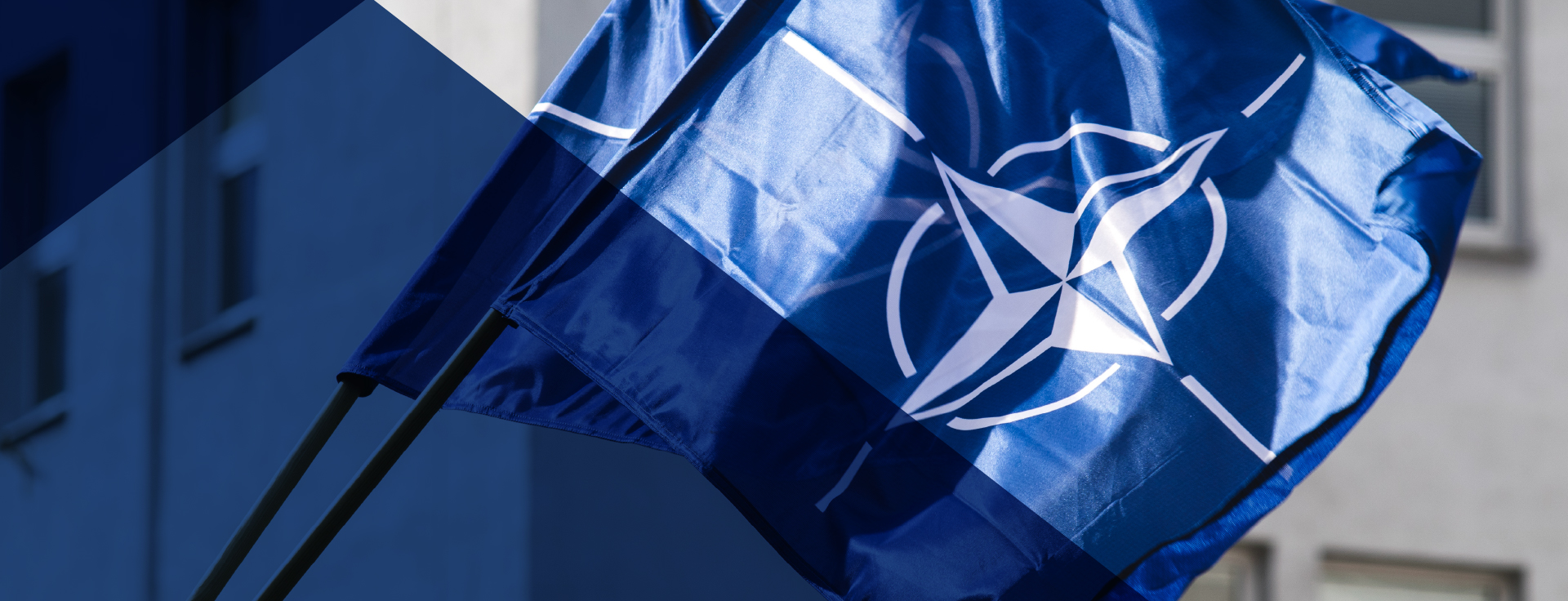NATO has been in the news a lot lately. Otherwise known as the North Atlantic Treaty Organization, the transnational military alliance includes 32 members, including the United States, and was established in the aftermath of World War II. The security pact is simple: each independent member state agrees to defend each other against attacks by other parties.
No doubt, member expansion and the current situation in Ukraine has led to heightened tensions between NATO and Russia. In addition, support for NATO has been heavily debated since 2018, when President Donald Trump began threatening to pull America out of the alliance. (Tatum, 2018) As you can imagine, NATO’s brand reputation has taken a hit — that will happen when the leader of the free world questions the United States’ commitment to defending its allies. Can social media help shift the narrative?
Goals and Objectives
NATO is extremely active across all their social media channels, including Facebook, X, LinkedIn, YouTube, Instagram, and even flickr. They often share more than one post a day to each platform. On Instagram alone, they’ve added over 3,400 organic posts since joining in 2017. (Yes, I scrolled all the way to the bottom.) Though NATO is a military alliance, their social media presence functions similar to a non-profit organization. They aren’t looking create conversions through sales, but have a herculean task of driving member support, managing public relations, and sustaining member loyalty. (Blanchard, 2011, pgs. 24-27)
Social Media Situation
Since Russia invaded Ukraine in February of 2022, NATO has been on a social media blitz to clearly define their role, answer public questions, and defend their purpose. Their YouTube page, for example, highlights an 8-minute video explaining why NATO was created, and how it helps to manage world crises. Beneath videos of NATO’s response to the Russian invasion of Ukraine, there’s an archive of videos expounding on its history — undoubtedly an attempt to assure the global public that NATO represents the good guys. Public Relations efforts like this represent a necessary campaign to combat Donald Trump’s criticism of member nations.

Perception
Unfortunately, public opinion is hard to sway, and many of NATO’s best social efforts have fallen short. Hootsuite’s social listening functionality shows that NATO has a 47.1% negative sentiment, compared to only a 4.3% positive sentiment. That’s worse than any president’s lowest approval rating, ever. (Harry Truman: 22% from 1951-1952, in case you were wondering.) This is not a small sample size, as engagement with NATO's brand across all channels represents more than 3M users, representing an enormous amount of reach. Moreover, negative sentiment spikes every time NATO is mentioned by President Trump in traditional media, and the long-term trend is heading in the wrong direction.

You wouldn’t glean such negativity by following their social media feeds. Their content includes striking photography and videography of military drills from member countries. The most recent video contains a simple infographic containing a list of items that are “in” for 2025, like “Supporting Ukraine,” and “Strengthening unity among 32 Allies.” The much shorter “out” column shows two items: “Russian forces in Ukraine,” and “Destabilizing acts by malign actors.” Infographics are a great way to increase brand visibility and are easily shareable. (Thony, 2024, pg. 26) As of this writing, the Instagram post has 9,358 likes and almost 300 comments. Engagement rate is not the problem.

From an organic perspective, NATO seems to be doing everything the right way. They post high-quality content that’s informative and visually appealing. Short, impactful videos also help to capture attention. And, the reaction to their social feed is overwhelmingly positive, regularly getting over 10,000 likes, comments, and shares from their 1.5 million followers on Instagram, and 1.8 million followers on Facebook. Most importantly, in my opinion, they are defending their stance and holding true to their brand values. This only goes to show the stronghold that President Trump has over the political narrative in our country. Democracy used to be much easier to defend.
Redirecting the Narrative
Moving forward, NATO should certainly continue certain elements of the strategy they’ve devised — post frequently, use appropriate hashtags, and stay consistent with their visual and verbal tone of voice. (Wilson, 2024, para. 7) The general population gets a powerful glimpse into their global efforts. However, there is also a great opportunity for NATO to utilize social media in a way that’s going to help reinforce and redirect their narrative. First, they don't need to post multiple times a day to each channel. That's overkill, and it may actually deter engagement. A more sustainable approach would be 2-3 posts per week on the channels that are most impactful. Based on the available metrics, Instagram, Facebook, and YouTube are all working well. NATO can prioritize these channels and focus less on X, where the political commentary can be polarizing.
In order to optimize their content strategy, NATO can create user-generated content (UGC) from NATO members and soldiers. The Secretary General gets plenty of airtime on mainstream media but, from an organic standpoint, it would be more powerful to hear directly from those with their boots on the ground. What are they fighting for? NATO can encourage members to create and share their own photos and videos in the field. NATO can share this content in their own organic feeds. This would help tell a complete story and facilitate engaging conversations with civilians and possibly even legislators.
The data shows us that sentiment for NATO is negative, despite their enormous reach and positive engagement rate. A more emotional connection can be established by encouraging people to engage with real NATO members. They can repurpose their short UGC video segments to populate all of their social media channels, as well as their e-newsletter updates, that can help foster a sense community among NATO members, civilians, and politicians. (Thony, 2024, pg. 28) The idea is to continually reinforce the brand’s positive message on a more personal level.
Last, if they are to turn sentiment around in the media, there needs to be a concerted organic media effort to communicate with legislatures in the United States. Members of Congress, both in the House of Representatives and the Senate, have to understand the importance of NATO if they are to publicly defend it. When it comes time to vote, I can’t think of a more impactful statement than a stream of testimonials from soldiers around the world, representing democracy and standing up for freedom.
References
Blanchard, O. (2011). Social Media ROI. Pearson Education Inc.
Tatum, S. (2018, July 18). Trump seems to question US commitment to defending all NATO allies | CNN politics. CNN. https://www.cnn.com/2018/07/17/politics/trump-nato-fox/index.html
Thony, S. L. (2024). The Marketing Campaign Playbook. STK MKT Entertainment.
Wilson, C. (2024, December 20). Navigating the Social Media Algorithm for Organic Reach. Home. https://www.robineaumedia.com/blog/navigating-the-social-media-algorithm-for-organic-reach
Yakob, F. (2022). Paid attention: Innovative Advertising for a Digital World. Kogan Page Inc.

No Comments.